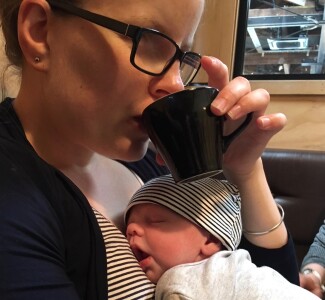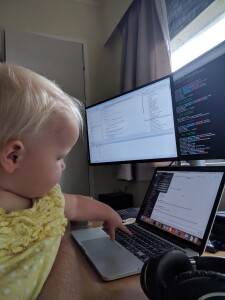“We’re a family-friendly company.” We’ve all heard businesses roll out this phrase as part of a modern recruitment strategy. As far as I can tell, most fall well short of delivering.
Before starting a family, such a selling point was never a game changer for me. However, the imminent arrival of a baby quickly changed that mindset. All of a sudden, Parental Leave, job security, childcare and flexible work hours were at the forefront of my mind. Any parent will tell you, it’s a financial and emotional juggle.

My return to work was always a sure thing. What shape it would take, and when it would happen was a bit more fluid, and my ideas shifted once my son, Lockie was born. In the end, I worked from home a few hours a week once he was four months old, and returned to work three days a week this month – the day after he crossed the six month milestone.
For those of us returning to work, an employer’s attitude to work-life balance becomes a pretty major consideration. My own decision making process prompted me to look more closely at our parental leave laws and employer obligations, and consider the many ways we parents handle the balance. After chatting to members of the Media Suite crew, it’s pretty clear everyone strikes that balance a little differently.
What shone through, was the clear need for one thing – flexibility. And it’s not enough for it to come from just one angle. Working parents in 2018 need flexible work, flexible childcare and flexible government support. It’s only when all these things finally align, that I think we’ll see meaningful change in the happiness of our parenting workforce and the necessary shift in our workforce norms around gender expectations and productivity.
Here’s the Problem
Having a family these days comes with a whole host of challenges. Many families rely on two incomes to make ends meet. Some families want to share the caring work at home, others find that both parents wish to retain their professional identities and career opportunities and need additional flexibility or support around childcare arrangements. For many in today’s workforce, it can come down to being home for the family dinner, or putting in a few more hours at the office. Choosing (or being pressured to) miss your child’s school play/sports game/dance recital to work can make all the difference in how supported you feel in your workplace.
There is no shortage of employers that seem to expect work should trump family every time. There is no shortage of parents out there who feel pressure or judgment from their colleagues on the occasions they put the needs of their child ahead of completing the working day. So how do we strike the balance?
In New Zealand, the legal allowances made for parents fall well short of the gold standard. Some countries offer a year of more of leave, paid at the parent’s normal salary rate or part thereof. Many allow specific leave for the father or non-birth parent, and some insist on this to promote bonding between a child and both their parents.
Parental Leave, particularly, has been a hot topic in New Zealand, of late. With the Prime Minister expecting, and a new government in charge, changes are afoot and scrutiny has never been higher.
At the moment, New Zealand’s Parental Leave laws allow for 18 weeks paid leave, at a maximum of $538.55 weekly before tax, extending to 22 weeks beginning in July. Parents can choose to share this leave between them, but there is no provision for additional leave for fathers. After the “paid” period is up, any additional leave is unpaid.
Being Part of the Solution
Anyone reading the comments section on an online news article will see the nation can be divided when it comes to offering special circumstances or entitlements for families. For those of us who would like to see changes made, it requires three key areas to align – workplace flexibility, childcare options and government support.
The Government Bit
Almost all Media Suite parents mentioned they would love to see more flexibility in the way each family is able to manage its government entitlements, to reflect the different needs in their household. Parental Leave law changes in 2016 were a good start, but mother of three and Commercial Manager, Abi, thinks more flexibility is key.
Keeping professionally relevant, staying connected – and being able to bring in a little economic contribution to your family – is really meaningful on both sides of the employment relationship. Ideally I’d like to see more KIT hours available and potentially the ability to spread your parental leave package differently so you can scale up a return to work in a more supported way. – Abi
When I was on maternity leave, I valued a bit of paid work time here and there during nap time or in the evening. Especially because I found that government maternity leave payments were nice to have and much appreciated, but below my typical income level and for too short a time. Again, those European countries are setting a high bar by paying at, or a percentage of the parent’s usual income to reflect their usual living costs. It’s easy to see how parents can feel under pressure to return to work ahead of their readiness when finances are stretched.

When it comes to parenting and the workforce, times, and gender expectations, have definitely changed. But while we would like to think that women ‘of a certain age’ aren’t discriminated against in the hiring or promotion process, many women report that this is still going on. A few changes to parental leave laws could help level the playing field.
For the non-birth parent to have, not just a chance, but an economic incentive to stay at home with an infant really helps to break down gender-based expectations about where nurturing care should happen. – Abi
Almost all Media Suite families wished there was paid leave offered to the non-birth parent, encouraging bonding between both parents and their child in the early days. Too often we see one parent having to race back to work to keep the money coming in, and missing important time with their new baby. If employers knew both parents would take a paid leave entitlement at some point, perhaps hiring prejudices could also be weakened.
The Childcare Bit
Working parents will know how important trusted child care is. However, the real sweet spot is found when that care is also flexible – whether that means being able to afford (or wanting to be) a stay at home parent, or having access to family or professional carers.
Abi’s kids are fortunate to have access to a community, not for profit preschool which runs totally flexible hours with seriously affordable fees and high staff:child ratios. As such, she has been comfortable working consistent part-time hours even with very young children, without having to compromise on her preferences around feeding and parenting philosophy. Flexible childcare options which truly support the needs and preferences of working parents also play a huge part in finding work-life balance.

In my family, I am lucky to have very enthusiastic and engaged grandparents. At the moment, I am privileged to have my mum caring for my son three days a week. This transition time, where I can have a family member at home with him, has made my return to work a lot less stressful.
Childcare also goes beyond reliance on professional providers or extended family. A few of our Media Suite dads have chosen to scale back their own work hours (either temporarily or permanently) to stay home with their children so their partners can get back into the workforce – something Media Suite really strives to support.
The Work Part
At Media Suite, work-life balance is less myth, and more reality. For some, it’s being able to surf when the waves are good. For others, it’s walking the dogs in the lunch hour, or leaving early to hit the gym. It also works for us as parents.
For those with families, balance can be particularly hard to achieve, with many parents feeling like they are failing at both (even when they aren’t). Media Suite tries to make achieving balance a little easier. As a team, we talk openly about managing stress, juggling family needs and fitting in high quality down-time. Above all, we focus on getting great quality work done when it is needed, and less on being seen in the office 8.30 to 5.30, Monday to Friday.
One tangible benefit Media Suite offers to everyone is an additional week’s leave when a new addition to a family is expected – paid at normal Annual Leave rates. No requirements or constraints are placed around where and when this leave is used. Some team members have used the ‘free week’ straight after the birth, to assist with care of older children or bond with the new baby. Some have taken it instead of unpaid leave, others have taken it to reduce working hours in the late stages of pregnancy. Media Suite also strives to offer maximum flexibility to parents who might want to take a longer period of unpaid leave or work significantly reduced hours over a longer period.

Last year, I used my 40 hours across the last month of my pregnancy, starting work later in the day. It allowed me to sleep in a bit and get a bit of exercise. I was in the process of handing off my duties to another staff member, so the gradual scale-back worked for everyone involved. Developer Ewen saved his leave hours for “down the track” when his daughter (their third child) was born. Jonathan used his to extend his leave when his daughter was born over the Christmas break.
As with any flexibility sought by a member of the team, implementation varies based on personal circumstances and preference combined with the requirements of your role. Wherever flexibility is found, it is the product of balancing the needs of the impacted project or team with the needs of the family unit. At the end of the day, every single family is different (and its needs change over time). A ‘one size fits all’ policy makes little sense, instead we talk openly about what everybody needs to find the best solution.
Flexibility is not just for new babies. Many of our team have older dependant family members, young families, or slightly older children. Just because our kids are growing up, doesn’t mean they don’t need us (in fact, their problems seem to become more complex). There are always school drop-offs, special events, sick days, sports games and holidays (and more holidays). For many families, our remote work culture can make all the difference, allowing hours to be caught up from home, in the evenings or early morning. Proper support of remote working solutions is critical.
Greta joined Media Suite last year and really values the options she has now. She often works from home, after her daughter has gone to bed, which lets her bring in a full time income while also spending quality time with her family.
A fulfilling family life and a satisfying career. Media Suite helps by understanding that life outside work is important too. They understand that you can care about both work and home, and that caring about both doesn’t make you less valuable as an employee. – Greta
Developer Mark has three kids and often manages to attend their daytime school events, doctor/dentist appointments etc as well as being home for the 5:30pm family meal, choosing to make up the missed time later in the evening when the kids are in bed. His dream is work-life balance that looks like a four-day week/three-day weekend.

When you have multiple kids at school events seem to be every other week. I feel really lucky to be able to attend those events in the majority of cases, and just work a bit extra in the evening, or the next day, to make up for it. – Mark
The Media Suite culture is a key part of any flexible work solution, whether that be for parents, or to support the team in their lifestyle choices, passions, or managing health and wellbeing. The key for us is fostering leadership and professional disciplines which allow employees to arrange their flexibility without fear of repercussions or a change in relationship dynamics within their team. That obviously requires a highly professional team, who care about their work and are committed to not letting down their project team or clients. In that sense flexibility walks in hand with accountability.
When the commitment to delivery is genuine, the way we regard working parenthood can become more realistic. Nearly every member of the team I spoke with recalls babies sleeping on parents during stand-ups, kids busting into video-calls, older children diligently working on their colouring-in while something got finished in the office – not to mention ongoing turf wars over home office space occupied by toys. Then there was that one guy who thought his life “wouldn’t change too much” after his daughter was born (this comment has since been retracted).

The team which takes all this in stride and focuses on outcomes can absolutely afford to support working parents with meaningful flexibility. The first step in this relationship is a conscious decision to hire people responsible and professional enough to take an active role in managing their work-life balance. Media Suite’s approach relies on trust, good communication and adherence to professional standards.
Where to From Here?
I doubt anyone can say they have it all perfectly squared away. Some of our team still aim to balance their lives a little better. Rarely is there a picture-perfect solution.
Work-life balance should be something we can all be actively working towards. I would like to see more employers supporting families, and better government policies for families to tailor their support package to suit their needs. Ideally, parents would be able to access flexible child care which allows them to return to work when they’re ready, at a cost they can afford.

The lack of connection between our national policies and the reality of parenting can’t be lost on everyone. On the one hand, mothers are expected to breastfeed for at least six months, but they’re offered only 18 weeks Maternity Leave. After that, the cost of childcare is not mitigated until free ECE hours kick in when a child turns three. Many households needing two incomes must then choose between unpaid leave and the loss of one income, or a return to work with an income reduced by childcare cost – and that’s without considering what’s best for the family unit beyond just the bottom dollar. Having better support in the workplace would no doubt make such a transition time a whole lot easier for working parents who really feel the gaps in our legislation.
At the moment, all eyes are on our fearless leader, Prime Minister Jacinda Ardern, as she approaches one of the most public work-life balance challenges this country has seen. I would imagine many Kiwis, particularly working parents, are silently praying she pulls it off. If she does, her example could be a valuable spotlight on what can be achieved with the right support. She has pledged a six-week leave followed by a return to work, with her partner taking on the primary caregiver role. Perhaps her own situation will prompt her to closely consider how other parents might be managing without the same support networks. Fingers crossed we will be celebrating her success as a catalyst for change.
Shout out to the awesome Media Suite team for contributing to this blog post and sharing their beautiful families.














